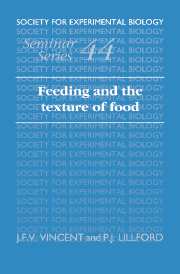Book contents
- Frontmatter
- Contents
- List of contributors
- Introduction
- Mechanical and fracture properties of cellular and fibrous materials
- Texture of plants and fruits
- Measuring meat texture and understanding its structural basis
- Food processing by mastication in cyprinid fish
- Quantitative aspects of the relationship between dentitions and diets
- The control of movements and forces during chewing
- The basic mechanics of mastication: man's adaptive success
- Integrating texture and physiology – techniques
- Brittle textures in processed foods
- The control and generation of texture in soft manufactured foods
- Texture and acceptability of human foods
- Index
Texture of plants and fruits
Published online by Cambridge University Press: 14 January 2010
- Frontmatter
- Contents
- List of contributors
- Introduction
- Mechanical and fracture properties of cellular and fibrous materials
- Texture of plants and fruits
- Measuring meat texture and understanding its structural basis
- Food processing by mastication in cyprinid fish
- Quantitative aspects of the relationship between dentitions and diets
- The control of movements and forces during chewing
- The basic mechanics of mastication: man's adaptive success
- Integrating texture and physiology – techniques
- Brittle textures in processed foods
- The control and generation of texture in soft manufactured foods
- Texture and acceptability of human foods
- Index
Summary
This chapter is about the problems that animals have when they try to feed on plants. Some bits of plants (e.g. fruits) are adapted to be eaten, but most of the rest of plants is not. The act of feeding on a plant involves fracture at a number of size levels. The possibility that parts of plants may have mechanisms to resist fracture by animals feeding on them has not been seriously and competently considered, except possibly for a small range of plants associated with domestic animals. In this instance, plants have been developed which are more ‘palatable’. Since palatability is mostly measured in terms of intake, this often means that the plant is easier to harvest (e.g. easier to grasp, as Owen (1976) suggests for geese harvesting grasses) or weaker (Theron & Booysen, 1966; Owen, Nugent & Davies, 1977), though if the plant is too weak or brittle then the plant can break down too quickly inside the animal, which can lead to bloat. However, brittleness could be a means of defence by the plant, i.e. by abscission, which limits damage in the main part of the plant when the animal harvests part of it, or by limiting the amount of nutrient available to the animal. A brittle fracture would go straight through an assemblage of cells, opening as few cells as possible and thus releasing as little nutrient as possible: a toughening mechanism would inevitably spread damage within the plant material, causing more cells to be damaged, releasing more nutrient. An animal might therefore learn to reject a brittle plant which released little food.
- Type
- Chapter
- Information
- Feeding and the Texture of Food , pp. 19 - 34Publisher: Cambridge University PressPrint publication year: 1991
- 5
- Cited by



